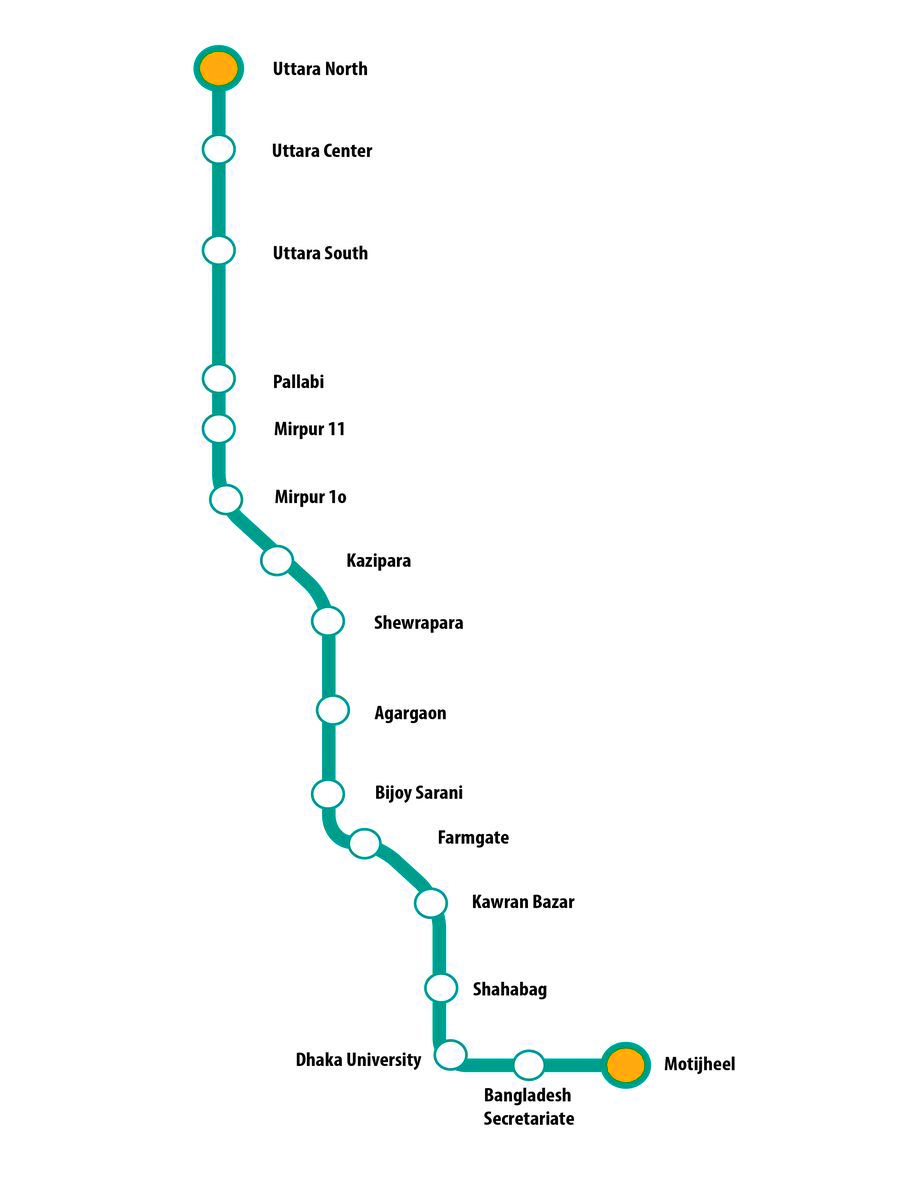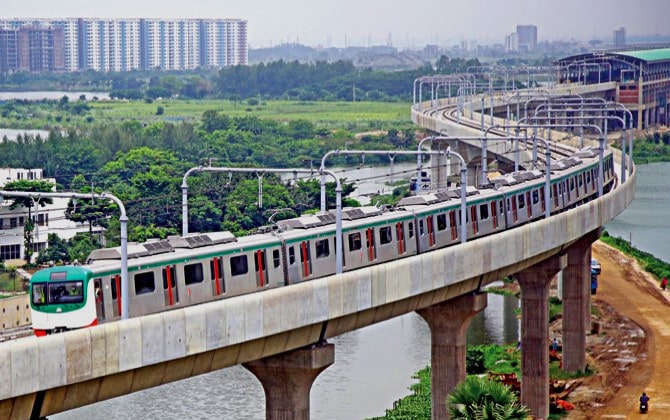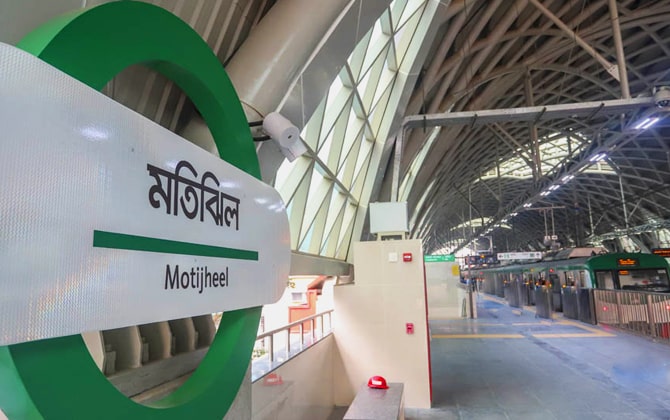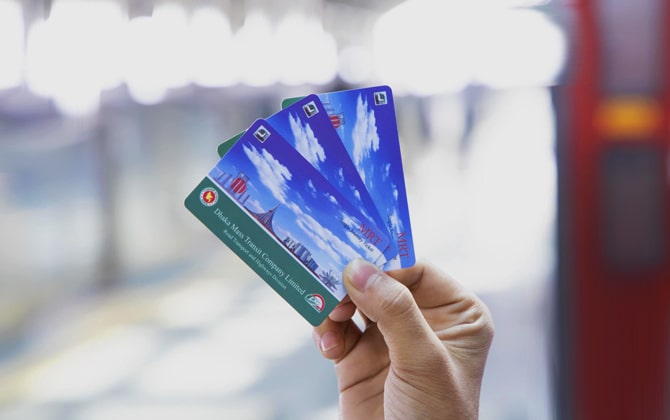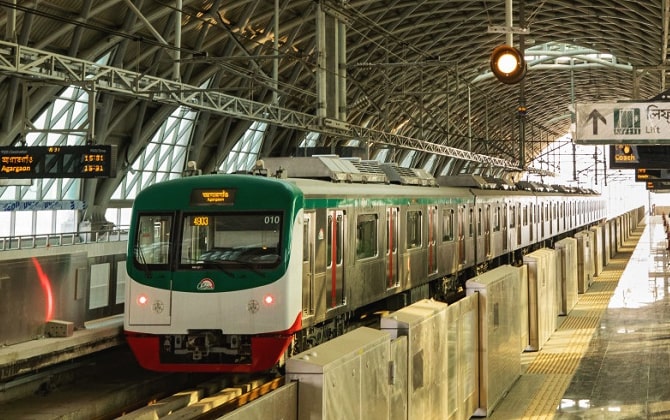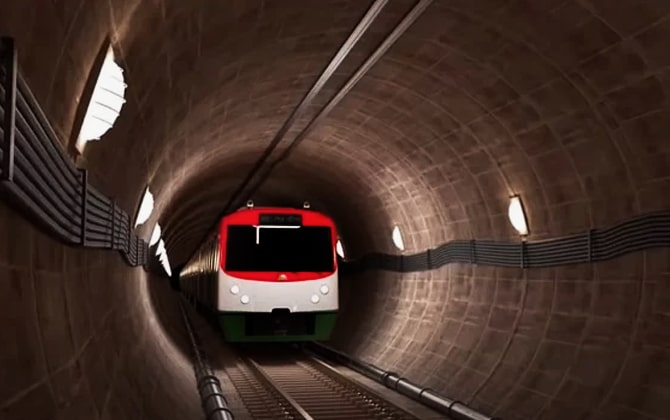Dhaka Metro Rail is Bangladesh’s first mass rapid transit system. It opened on 29 December 2022 and is owned and operated by Dhaka Mass Transit Company Ltd (DMTCL). The metro aims to ease Dhaka’s severe traffic congestion and forms a key part of the city’s Strategic Transport Plan. The current line, MRT Line-6, runs north to south across Dhaka. Other lines are planned or under construction. Along with the proposed subway, bus rapid transit (BRT), and rail links, the metro will serve as the backbone of Dhaka’s future public transit network.
Dhaka Metro Map
Dhaka Metro map shows the route of MRT Line-6 (Uttara–Motijheel) and planned lines. The operational line spans 20.1 km (12.5 mi). The line runs along major north–south corridors near the Turag and Buriganga rivers. It links northern suburbs to the central business district.
Click on the map to enlarge it or download the Dhaka Metro map in PDF format.
Dhaka Metro Lines and Stations
Current service: Only MRT Line-6 is in operation. This elevated line has 16 stations:
- Uttara North (terminal): Uttara suburb, north Dhaka
- Uttara Center: Uttara business district
- Uttara South: Southern part of Uttara
- Pallabi: Near Daffodil International University, on Mirpur Road
- Mirpur-11: Near Bangladesh Institute of Sports
- Mirpur-10: Near Shahjalal International Cricket Stadium
- Kazipara: Intersection of Mirpur 8 and 9
- Shewrapara: Close to technical training institutes
- Agargaon: Government agencies near the Secretariat
- Bijoy Sarani: Near Bangladesh Bank on Mirpur Road
- Farmgate: Major bus terminals and Dhaka Commerce College
- Karwan Bazar: Wholesale market area
- Shahbag: University area near Dhaka Zoo
- Dhaka University: Arts Faculty on the campus
- Bangladesh Secretariat: Government Secretariat complex
- Motijheel (terminal): Main financial district
Other lines (planned/under construction):
- MRT Line-1 (Airport Line): Under construction. This 19.9 km (12.4 mi) route will link Shahjalal International Airport to Kamalapur (Dhaka Railway Station). It is Bangladesh’s first underground metro and is due to open around 2026.
- MRT Line-5 (Northern Route): Construction began in November 2023 and is due around 2028. This ~20 km (12.4 mi) line will run from Hemayetpur (Savar) through Mirpur to connect with Line-6 at Mirpur. A southern branch to Aftab Nagar/Badda is planned.
- MRT Lines 2 & 4: In planning. Line 2 will run from Gabtoli to Kamalapur via old Dhaka. Line 4 was proposed to link Kamalapur to Narayanganj but may be shelved.
Future expansions: MRT Line-6 will extend south from Motijheel to Kamalapur by 2026. Later, it will reach Tongi, Gazipur, and Savar. When complete, Dhaka Metro will cover most city and suburban corridors.
Dhaka Metro Schedule and Timetable
Operating hours (opening and closing times)
The Dhaka metro operating hours change by day. From Sunday to Thursday, service starts at 7:10 AM from Uttara North and at 7:30 AM from Motijheel. Trains run until about 9:00 PM from Uttara North, with the last arrival at Motijheel shortly after.
On Saturday, hours mirror weekdays: first trains at 7:10 AM/7:30 AM and last trains around 9:00 PM. Friday service begins later for prayers. Since January 2026, trains run 3:00 PM–9:00 PM on Fridays. The first Friday train leaves Uttara North at 3:00 PM and Motijheel at 3:20 PM. Last departures are 9:00 PM northbound and 9:40 PM southbound.
Frequency and intervals
Trains run every 8–10 minutes during operating hours. Sunday–Thursday headways are eight minutes in peaks (7:30–11:30 AM and 2:30–8:20 PM) and ten minutes off-peak. Saturday follows the same 8–10 minute schedule. On Fridays, trains run every ten minutes between 3:00 PM and 9:00 PM.
Last train timing (closing time)
The final northbound train (Uttara North → Motijheel) departs around 9:00 PM Sunday–Thursday. The last southbound train (Motijheel → Uttara North) leaves at about 9:40 PM. Friday timings are identical.
Starting time and journey duration
The first trains depart Uttara North at 7:10 AM and Motijheel at 7:30 AM on regular days. A full end-to-end trip takes about 35 minutes.
Dhaka Metro Routes and Connectivity
MRT Line-6 forms a fast north–south spine through Dhaka:
- Uttara North: Near Uttara bus terminals with a future park-and-ride (bicycles only).
- Mirpur: Stations at Pallabi, Mirpur-11 and Mirpur-10 connect to major bus routes, universities and the cricket stadium.
- Farmgate & Karwan Bazar: Links to Gabtoli and Sayedabad bus terminals for easy transfers.
- Shahbag & Dhaka University: Serves the main student area and campus.
- Motijheel: Dhaka’s financial district with banks and offices.
Future extensions will link Line-6 to the Kamalapur Multimodal Hub and new metro lines at Notun Bazar (Line-1) and Mirpur (Line-5). The metro will tie into BRT corridors and suburban rail for full city coverage.
Dhaka Metro Ticket Prices & Fare Guide
Dhaka Metro Fares are distance-based: Tk 5 per km (~$0.04 USD). Minimum fare is Tk 20 (~$0.16 USD); maximum is Tk 100 (~$0.82 USD). A full 20 km (12.4 mi) ride from Uttara to Motijheel costs Tk 100 (~$0.82 USD). All passengers pay the same rate; no student discounts.
Ticket types:
- Single Journey Ticket: Paper token for one trip. Buy at station counters or TVMs.
- MRT Pass (Smart Card): Contactless stored-value Dhaka Metro card. Costs Tk 500 (~$4.10 USD), including a Tk 200 (~$1.64 USD) refundable deposit. Card is preloaded with Tk 300 (~$2.46 USD). Registration at station required. 10% fare discount.
- Rapid Pass: NFC card for metro and other public transport. Initial cost Tk 400 (~$3.28 USD), including a Tk 200 (~$1.64 USD) deposit. Available at DBBL branches or station kiosks. 10% metro fare discount.
Tap or insert your ticket/card at entry gates. Top up at TVMs: minimum Tk 100 (~$0.82 USD), maximum Tk 1,000 (~$8.20 USD) per transaction; balance cannot exceed Tk 10,000 (~$82 USD). Refund deposits at station counters.
Facilities & Services at Dhaka Metro Stations
Accessibility:
All stations have elevators, ramps, and tactile guidance. Platforms align with train floors for wheelchair access. Elevators feature braille buttons and lowered controls. You’ll find accessible restrooms and wide fare gates.
Ticketing and Information:
Stations offer staffed counters and TVMs for tokens and top-ups. Clear route maps, signage, and digital boards show arrivals. PA systems give audio updates. Network maps are posted throughout stations.
Comfort:
Stations are spacious and air-conditioned. Escalators link concourses to platforms. Seating and drinking water are available. Staff keep stations clean; bins discourage littering and spitting.
Security and Safety:
Passengers and bags pass through scanners at entry. CCTV covers all areas. Since early 2023, two MRT police officers patrol each train. Guards monitor every station. Fire safety and first-aid are onsite.
Other services:
No paid car parking or bike stands. Commuters must use nearby public parking or walk. Only light snacks are sold in designated outlets. Mobile signal is available underground.
Dhaka Metro Rules and Tips for Passengers
- Carry your ticket/pass: Have a valid token or tapped card before entry.
- Queue politely: Stand behind marked lines and let passengers exit first.
- Boarding & alighting: Wait for others to get off. Keep clear of doors and stand behind the yellow line.
- Women-only car: The first car is reserved for women and children.
- Priority seating: Offer seats to elderly, pregnant women, people with disabilities, and children.
- No food or drink: Eating and drinking are forbidden on platforms and trains.
- No smoking or spitting: Dhaka Metro is smoke-free. Use bins or designated areas.
- Bags and baggage: Only small bags or backpacks allowed. Large items and prohibited goods are banned.
- Behavior: Speak quietly and follow staff instructions. Use intercom or alarm in emergencies.
- Accessibility reminders: Avoid tactile paving. Ask staff if you need assistance.
Interesting Facts About Dhaka Metro Rail
- Bangladesh’s first metro system: The Dhaka metro system began service on 29 December 2022, inaugurated by Prime Minister Sheikh Hasina.
- Record ridership: Metro-6 carried about 350,000 passengers per day by early 2026. On 13 February 2026, it set a one-day record of 403,000 riders.
- High capacity: Each six-coach train carries over 2,300 passengers. The line can handle up to 60,000 passengers per hour at full operation.
- Modern trains: Kawasaki-Sifang built 24 cars (12 trains) under a Japan–China joint venture. Trains feature air-conditioning, digital displays, and automated announcements.
- Rapid trip: A non-stop run covers 20.1 km (12.5 mi) in about 35 minutes—far quicker than the 2+ hours by road in peak traffic.
- Accessibility leader: It is the first Bangladeshi transit system fully accessible to people with disabilities. Stations have ramps, elevators, Braille signage, audio aids, and wheelchair areas on trains.
- Costly build: The project cost about Tk 300 billion (USD 2.8 billion) for 20.1 km (12.5 mi), one of the highest per-kilometre costs in Asia due to tunnelling and utility relocation.
- Leadership: DMTCL, under the Ministry of Road Transport & Bridges, implements the project. DTCA ensures integration with other city transit plans.
Future Expansions of Dhaka Metro
- Line-6 Extensions: Extended south from Motijheel to Kamalapur by around 2026. Plans also include further northeast to Tongi and Gazipur. These links will integrate with Bangladesh Railway and suburbs.
- Line-1 (Airport to Kamalapur): Under construction. This 19.9 km (12.4 mi) underground and elevated line will open around 2026. It will connect Shahjalal International Airport directly to the metro.
- Line-5 (Northern Route): Construction began in late 2023. The route runs from Hemayetpur through Mirpur to Gabtoli, linking with Line-6 at Mirpur. A southern branch to Vatara/Amin Bazar is planned; service is due in the late 2020s.
- Other lines: Lines 2 and 4 are in detailed planning. Line 2 may reroute through Old Dhaka. Line 4 could be postponed in favour of upgraded commuter rail. Phase II of Line 5 may extend to Savar and Amulia.
- Network vision: The Strategic Transport Plan envisions up to six lines across Dhaka. By 2030, a mix of underground and elevated corridors will link to BRT and suburban rail, reshaping mobility in the megacity.
